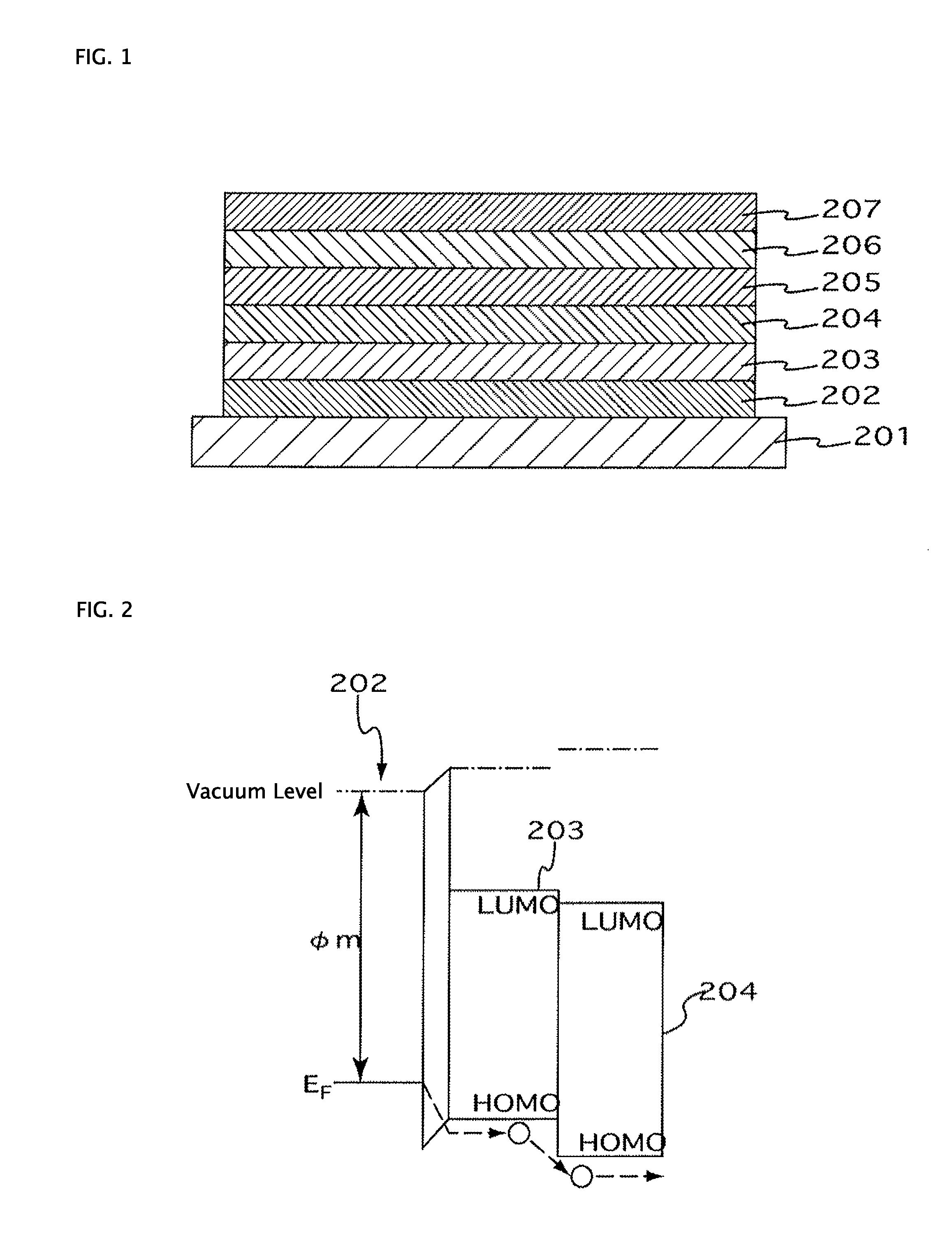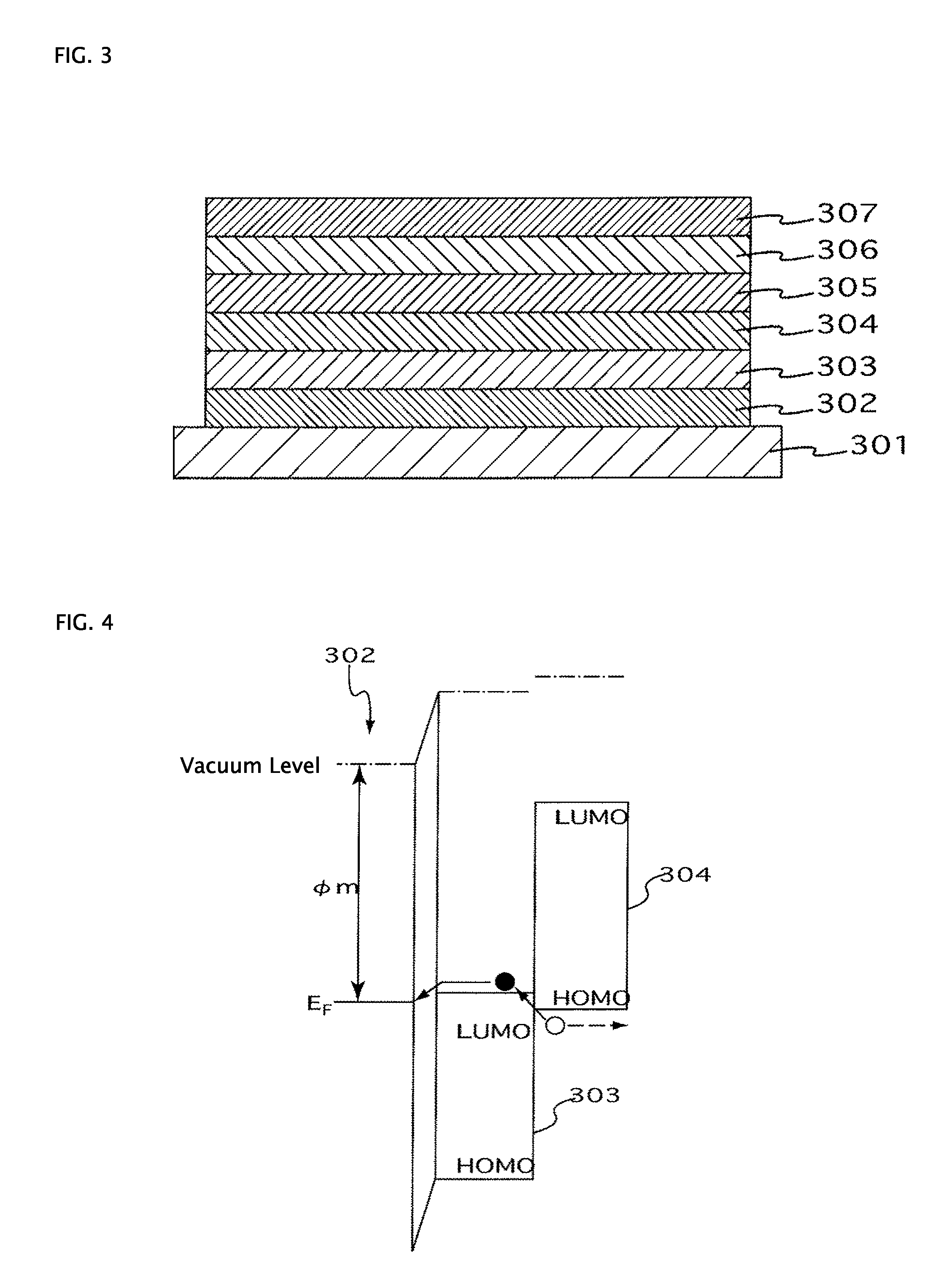Organic el device
a technology of organic el and el-type, applied in the direction of organic semiconductor devices, thermoelectric devices, solid-state devices, etc., can solve the problems of increased drive voltage, reduced production yield of display panels, and device defects, and achieve excellent hole injection capacity and electron transport capacity, high electron mobility, and the effect of increasing the thickness of the layer
- Summary
- Abstract
- Description
- Claims
- Application Information
AI Technical Summary
Benefits of technology
Problems solved by technology
Method used
Image
Examples
reference example 1
[0101]The object of the present reference example is to verify the height of carrier mobility in the hole injection layer used in the organic EL device in accordance with the present invention. An IZO film with a thickness of 110 nm was formed on a glass substrate (length 50 mm×width 50 mm×thickness 0.7 mm; Corning 1737 glass) by using a DC magnetron sputtering method (target: In2O3+10 wt. % ZnO, discharge gas: Ar+0.5 vol. % O2, discharge pressure: 0.3 Pa, discharge power: 1.45 W / cm2, substrate conveying rate 162 mm / min). An IZO electrode was then formed by processing the obtained IZO film by photolithography to a stripe shape with a width of 2 mm.
[0102]An NPB-doped HAT-6CN film with a thickness of 100 nm was then formed by resistance heating vapor deposition of HAT-6CN (Ip≈5.8 eV) and NPB (Ip=5.4 eV) simultaneously on the IZO electrode. In this case, the vapor deposition rate of HAT-6CN was set to 1 Å / s and the vapor deposition rate of NPB was set to 0.25 Å / s. The content of NPB in...
reference example 2
[0104]A model device was obtained by repeating the procedure of Reference Example 1, except that the NPB deposition rate was set to 1.75 Å / s. The content of NPB in the obtained NPB-doped HAT-6CN film calculated from a film thickness ratio was about 45 mol % based on the total number of molecules in the film.
example 1
[0108]Corning 1737 glass (length 50 mm×width 50 mm×thickness 0.7 mm) was used as the substrate 101. An IZO film with a thickness of 110 nm was formed on the substrate 101 by using a DC magnetron sputtering method (target: In2O3+10 wt. % ZnO, discharge gas: Ar+0.5 vol. % O2, discharge pressure: 0.3 Pa, discharge power: 1.45 W / cm2, substrate conveying rate 162 mm / min). A positive electrode 102 with a film thickness of 110 nm and a width of 2 mm was then formed by processing the obtained IZO film by photolithography to a stripe shape with a width of 2 mm.
[0109]A hole injection layer 103 composed of a NPB-doped HAT-6CN film with a thickness of 200 nm was then formed on the positive electrode 102 by resistance heating vapor deposition of HAT-6CN and NPB simultaneously. In this case, the deposition rate of HAT-6CN was set to 1 Å / s and the deposition rate of NPB was set to 0.9 Å / s. The content of NPB in the obtained hole injection layer 103 calculated from a volume ratio was about 30 mol %...
PUM
 Login to View More
Login to View More Abstract
Description
Claims
Application Information
 Login to View More
Login to View More - R&D
- Intellectual Property
- Life Sciences
- Materials
- Tech Scout
- Unparalleled Data Quality
- Higher Quality Content
- 60% Fewer Hallucinations
Browse by: Latest US Patents, China's latest patents, Technical Efficacy Thesaurus, Application Domain, Technology Topic, Popular Technical Reports.
© 2025 PatSnap. All rights reserved.Legal|Privacy policy|Modern Slavery Act Transparency Statement|Sitemap|About US| Contact US: help@patsnap.com



